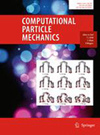GENERAL OBJECTIVES: Computational Particle Mechanics (CPM) is a quarterly journal with the goal of publishing full-length original articles addressing the modeling and simulation of systems involving particles and particle methods. The goal is to enhance communication among researchers in the applied sciences who use "particles'' in one form or another in their research. SPECIFIC OBJECTIVES: Particle-based materials and numerical methods have become wide-spread in the natural and applied sciences, engineering, biology. The term "particle methods/mechanics'' has now come to imply several different things to researchers in the 21st century, including: (a) Particles as a physical unit in granular media, particulate flows, plasmas, swarms, etc., (b) Particles representing material phases in continua at the meso-, micro-and nano-scale and (c) Particles as a discretization unit in continua and discontinua in numerical methods such as Discrete Element Methods (DEM), Particle Finite Element Methods (PFEM), Molecular Dynamics (MD), and Smoothed Particle Hydrodynamics (SPH), to name a few.
一般目标:计算粒子力学(CPM)是季刊,目的是发表有关涉及粒子和粒子方法的系统的建模和仿真的全长原始文章。目标是加强应用科学研究人员之间的交流,他们在研究中以一种或另一种形式使用“粒子”。具体目标:基于粒子的材料和数值方法已在自然科学和应用科学,工程学,生物学。术语“粒子方法/力学”现在已经对21世纪的研究人员暗示了几种不同的东西,包括:(a)颗粒作为颗粒介质、颗粒流动、等离子体、群体等中的物理单元,(b)代表材料相的颗粒在中观,在数值方法(例如离散元方法(DEM),粒子有限元方法(PFEM),分子动力学(MD)和平滑粒子)中,微米和纳米级和(c)粒子作为连续和不连续的离散单元流体动力学(SPH),仅举几例。
About the nuclear particles’ structure and dimensions
来源期刊:Computational Particle MechanicsDOI:10.1007/S40571-018-0206-7
Grains3D, a flexible DEM approach for particles of arbitrary convex shape—Part III: extension to non-convex particles modelled as glued convex particles
来源期刊:Computational Particle MechanicsDOI:10.1007/S40571-018-0198-3
Numerical investigation of the mixed-mode failure of snow
来源期刊:Computational Particle MechanicsDOI:10.1007/s40571-019-00224-5
A new set of scaling relationships for DEM-CFD simulations of fluid–solid coupling problems in saturated and cohesiveless granular soils
来源期刊:Computational Particle MechanicsDOI:10.1007/S40571-019-00246-Z
The drag coefficient and settling velocity of natural sediment particles
来源期刊:Computational Particle MechanicsDOI:10.1007/S40571-019-00223-6
Calibration of discrete element model parameters: soybeans
来源期刊:Computational Particle MechanicsDOI:10.1007/S40571-018-0194-7
Role of the location and size of soluble particles in the mechanical behavior of collapsible granular soil: a DEM simulation
来源期刊:Computational Particle MechanicsDOI:10.1007/S40571-018-00216-X
Comparison between pure MPI and hybrid MPI-OpenMP parallelism for Discrete Element Method (DEM) of ellipsoidal and poly-ellipsoidal particles
来源期刊:Computational Particle MechanicsDOI:10.1007/S40571-018-0213-8
A conservative and consistent Lagrangian gradient smoothing method for simulating free surface flows in hydrodynamics
来源期刊:Computational particle mechanicsDOI:10.1007/S40571-019-00262-Z
A bonded discrete element method for modeling ship–ice interactions in broken and unbroken sea ice fields
来源期刊:Computational particle mechanicsDOI:10.1007/S40571-019-00259-8
Effect of rock shape representation in DEM on flow and energy utilisation in a pilot SAG mill
来源期刊:Computational Particle MechanicsDOI:10.1007/S40571-019-00226-3
3D numerical simulations of granular materials using DEM models considering rolling phenomena
来源期刊:Computational Particle MechanicsDOI:10.1007/S40571-018-0200-0
Investigating the dissipative effects of liquid-filled particle dampers using coupled DEM–SPH methods
来源期刊:Computational Particle MechanicsDOI:10.1007/S40571-018-0212-9
Comparison of two numerical approaches (DEM and MPM) applied to unsteady flow
来源期刊:Computational Particle MechanicsDOI:10.1007/S40571-019-00236-1
Extension of B-spline Material Point Method for unstructured triangular grids using Powell–Sabin splines
来源期刊:Computational Particle MechanicsDOI:10.1007/s40571-020-00328-3
Analytic laws for direct calibration of discrete element modeling of brittle elastic media using cohesive beam model
来源期刊:Computational Particle MechanicsDOI:10.1007/S40571-018-00221-0
Artificial neural network-based prediction of effective thermal conductivity of a granular bed in a gaseous environment
来源期刊:Computational Particle MechanicsDOI:10.1007/S40571-019-00228-1
Modeling heat flow across material interfaces and cracks using the material point method
来源期刊:Computational Particle MechanicsDOI:10.1007/S40571-018-0201-Z
Preliminary effort in developing the smoothed material point method for impact
来源期刊:Computational Particle MechanicsDOI:10.1007/S40571-018-0197-4
Improvements in highly viscous fluid simulation using a fully implicit SPH method
来源期刊:Computational Particle MechanicsDOI:10.1007/S40571-019-00231-6
Modeling damage and plasticity in aggregates with the material point method (MPM)
来源期刊:Computational Particle MechanicsDOI:10.1007/S40571-018-00218-9
An improvement of rigid bodies contact for particle-based non-smooth walls modeling
来源期刊:Computational Particle MechanicsDOI:10.1007/S40571-019-00233-4
Implementation of an unresolved stabilised FEM–DEM model to solve immersed granular flows
来源期刊:Computational Particle MechanicsDOI:10.1007/S40571-018-0209-4
Numerical and experimental investigation of an elastoplastic contact model for spherical discrete elements
来源期刊:Computational Particle MechanicsDOI:10.1007/S40571-018-00219-8
Hysteretic behavior using the explicit material point method
来源期刊:Computational Particle MechanicsDOI:10.1007/S40571-018-0195-6
Modeling earthquakes with off-fault damage using the combined finite-discrete element method
来源期刊:Computational Particle MechanicsDOI:10.1007/s40571-020-00335-4
CFD simulation of cross-flow mixing in a packed bed using porous media model and experimental validation
来源期刊:Computational Particle MechanicsDOI:10.1007/S40571-018-0203-X
How to model orthotropic materials by the discrete element method (DEM): random sphere packing or regular cubic arrangement?
来源期刊:Computational Particle MechanicsDOI:10.1007/S40571-018-0202-Y
Convergence study and optimal weight functions of an explicit particle method for the incompressible Navier–Stokes equations
来源期刊:Computational Particle MechanicsDOI:10.1007/s40571-019-00247-y
Effect of the integration scheme on the rotation of non-spherical particles with the discrete element method
来源期刊:Computational Particle MechanicsDOI:10.1007/S40571-019-00232-5
Three-dimensional flow prediction in mould filling processes using a GFDM
来源期刊:Computational Particle MechanicsDOI:10.1007/S40571-019-00222-7
Study on one-dimensional softening with localization via integrated MPM and SPH
来源期刊:Computational Particle MechanicsDOI:10.1007/S40571-019-00242-3
Effect of density ratio on the dispersion of particles in a submerged liquid jet
来源期刊:Computational Particle MechanicsDOI:10.1007/S40571-019-00234-3
A DEM investigation of water-bridged granular materials at the critical state
来源期刊:Computational Particle MechanicsDOI:10.1007/S40571-019-00243-2
Discrete solid element model applied to plasticity and dynamic crack propagation in continuous medium
来源期刊:Computational Particle MechanicsDOI:10.1007/S40571-019-00237-0
Simulations for the explosion in a water-filled tube including cavitation using the SPH method
来源期刊:Computational Particle MechanicsDOI:10.1007/S40571-019-00230-7
Tracking of material orientation in updated Lagrangian SPH
来源期刊:Computational Particle MechanicsDOI:10.1007/S40571-019-00225-4
Investigation of the mechanical responses of copper nanowires based on molecular dynamics and coarse-grained molecular dynamics
来源期刊:Computational Particle MechanicsDOI:10.1007/S40571-018-0205-8
Comparison of multiphase SPH and LBM approaches for the simulation of intermittent flows
来源期刊:Computational Particle MechanicsDOI:10.1007/s40571-019-00250-3
A new high-order particle method for solving high Reynolds number incompressible flows
来源期刊:Computational Particle MechanicsDOI:10.1007/S40571-018-00217-W
Application of smooth particle hydrodynamics (SPH) method in gravity casting shrinkage cavity prediction
来源期刊:Computational Particle MechanicsDOI:10.1007/S40571-019-00263-Y
Thermal analysis of large granular assemblies using a hierarchical approach coupling the macro-scale finite element method and micro-scale discrete element method through artificial neural networks
来源期刊:Computational Particle MechanicsDOI:10.1007/S40571-019-00265-W
A mathematical model for thermal expansion coefficient of periodic particulate composites
来源期刊:Computational Particle MechanicsDOI:10.1007/S40571-018-0196-5
An implicit unsteady hydraulic solver for suspended cuttings transport in managed pressure wells
来源期刊:Computational Particle MechanicsDOI:10.1007/S40571-018-0204-9
Modelling continuous materials using discrete element modelling: investigations on the effect of particle packing
来源期刊:Computational Particle MechanicsDOI:10.1007/S40571-019-00270-Z
High-performance computing in simulation of milk crown
来源期刊:Computational Particle MechanicsDOI:10.1007/S40571-018-0211-X
A material point method for simulation of viscoelastic flows
来源期刊:Computational Particle MechanicsDOI:10.1007/S40571-018-0215-6
Dilation angle in bonded particle simulation of rock
来源期刊:Computational Particle MechanicsDOI:10.1007/S40571-018-0208-5
Numerical modeling of the motion of otoconia particles in the patient-specific semicircular canal
来源期刊:Computational particle mechanicsDOI:10.1007/S40571-019-00260-1
An agent-based and FE approach to simulate cell jamming and collective motion in epithelial layers
来源期刊:Computational Particle MechanicsDOI:10.1007/S40571-018-0199-2




